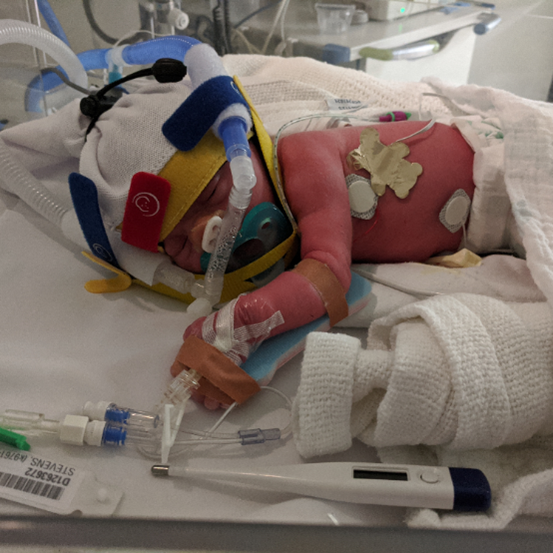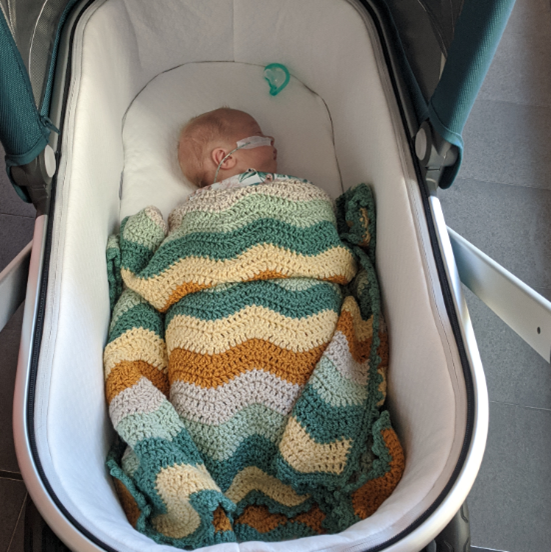Laura was born 30 weeks and 6 days, weighing 1,790 grams.
This story was sent to us by Australian parent organization Miracle Babies.

Our journey with prematurity began when I was 25 weeks and 5 days pregnant, during my first antenatal appointment. After we saw the midwife, she explained that the doctors had requested a scan because my cervix had measured on the short side at my 20-week scan. I had no idea what that meant. After the scan, the sonographer returned and said the obstetrician wanted to speak with me. I had to be taken in a wheelchair, which was very concerning.
I'll never forget the moment I was told Laura would likely be born preterm. The obstetrician broke the news and I was absolutely devastated. He explained that there is a link between short cervical length and preterm birth. My cervix had measured slightly short at 20 weeks and was now even shorter. The doctors examined me, and I was given steroid injections to help Laura's lungs in case she was born early – two doses, 24 hours apart. I received the first dose and was sent home. The following evening, I returned for the second dose and another check-up.
Unfortunately, things had progressed. I was now 2cm dilated. Further tests showed a high likelihood that I could go into labor at any moment. My husband, Hamish, had to drive me straight to King Edward Memorial Hospital, as Fiona Stanley was not equipped to deliver a baby at that gestation. I couldn't even go home to collect my things. I was terrified.
The next morning, at exactly 26 weeks, I was told that if Laura were born that day, there was an 80% chance she would be alright and not suffer long-term complications from her prematurity. The doctors explained that every additional day I remained pregnant would improve her chances. After five days, with no changes, I was discharged to rest at home. Just a week earlier, I had been working full time, exercising, and living a normal life. Only two weeks before, we had returned from a holiday on Christmas Island, where we had been swimming and hiking. Now, I could hardly do anything. I had never been in a position where I needed to ask for help. We were fortunate to receive support with cleaning, meals, and walking our dog. With our families in Tasmania and the WA border closed, we had limited family support.
Another four weeks passed, and I was still pregnant. I was beginning to feel more hopeful. Then, at 30 weeks and 6 days, I began feeling pains that became more intense and frequent, they advised me to come in. I had no idea I was in labor. We arrived at the hospital around 7pm. After a quick examination, the obstetrician told us Laura would soon be born, and I was transferred to the birth suite. There were so many people ready to care for her when she arrived.

Laura was born weighing 1,790 grams, after a very short labor. The obstetrician held her up for me to see before she was taken away. I couldn't see what was happening, and when she finally cried, it was such a relief. I saw her briefly again before she was taken to the neonatal unit. Hamish went with her. The room emptied, and I was left in the birth suite – alone, except for a midwife checking on me now and then. None of it felt how it was meant to be.
That night I visited Laura in the neonatal unit. She was connected to so many cords and wires. Her breathing support was CPAP, and monitors tracked her heart rate and respiration. She was being fed nutrients through an IV and kept in an incubator because she couldn't regulate her body temperature. At two days old, she started caffeine therapy to assist with her breathing. The equipment and terminology were all new to me – it felt like a different world.
At 6am the next morning, a midwife suggested I start expressing milk for Laura. It wasn't how I had imagined breastfeeding. I pumped and delivered the milk to the neonatal unit, where it was fed to Laura through an NG tube. This became so important to me – it felt like the only thing I could do for her. Deep down, I knew that just being there with her was just as important, but expressing milk felt more tangible.
I held Laura for the first time the day after she was born. Because of the CPAP, wires, and incubator, I needed help from the nurses. I had to ask for permission, and the answer wasn't always yes – they tried to limit the time she spent outside the incubator. I was discharged after two nights. Leaving the hospital without Laura felt so unnatural. Nothing can prepare you for the pain of leaving your baby behind. I visited her every day.
Two weeks later, Laura’s CPAP was removed and she was taken out of the incubator. We celebrated milestones like her first bath. I could hold her without needing permission. The final hurdle was for her to feed without the NG tube – then she could come home. It felt like forever. I tried to breastfeed, and the nurses supplemented with bottles overnight. We learnt to tube-feed so she might come home sooner, still using the NG tube at times. Direct breastfeeding didn't work for us – due to her prematurity, Laura had a high-arched palate that made it nearly impossible. I continued expressing milk for her until she was 13 months old.
Laura came home after 46 days in hospital – two weeks and four days before her due date. She remained on tube and bottle feeds for another two weeks. While she had ongoing feeding difficulties and was slow to gain weight, she is now very healthy with no lasting effects from her prematurity.
Laura was born 30 weeks and 6 days, weighing 1,790 grams.
This story was sent to us by Australian parent organization Miracle Babies.